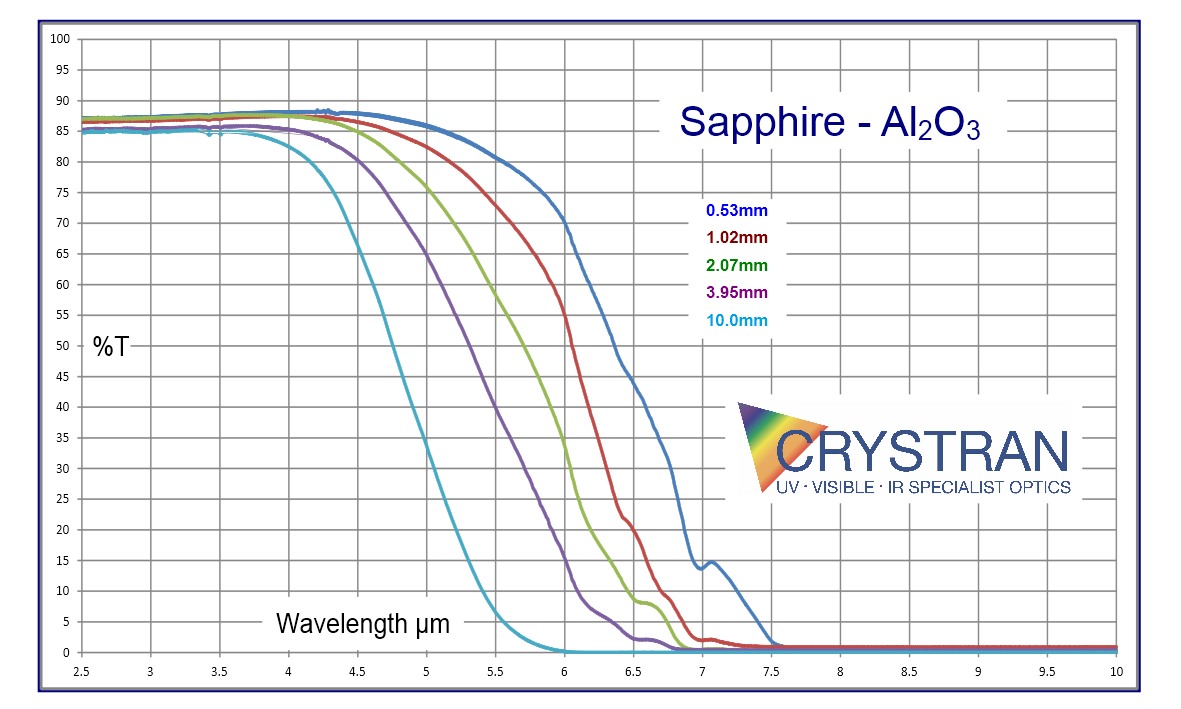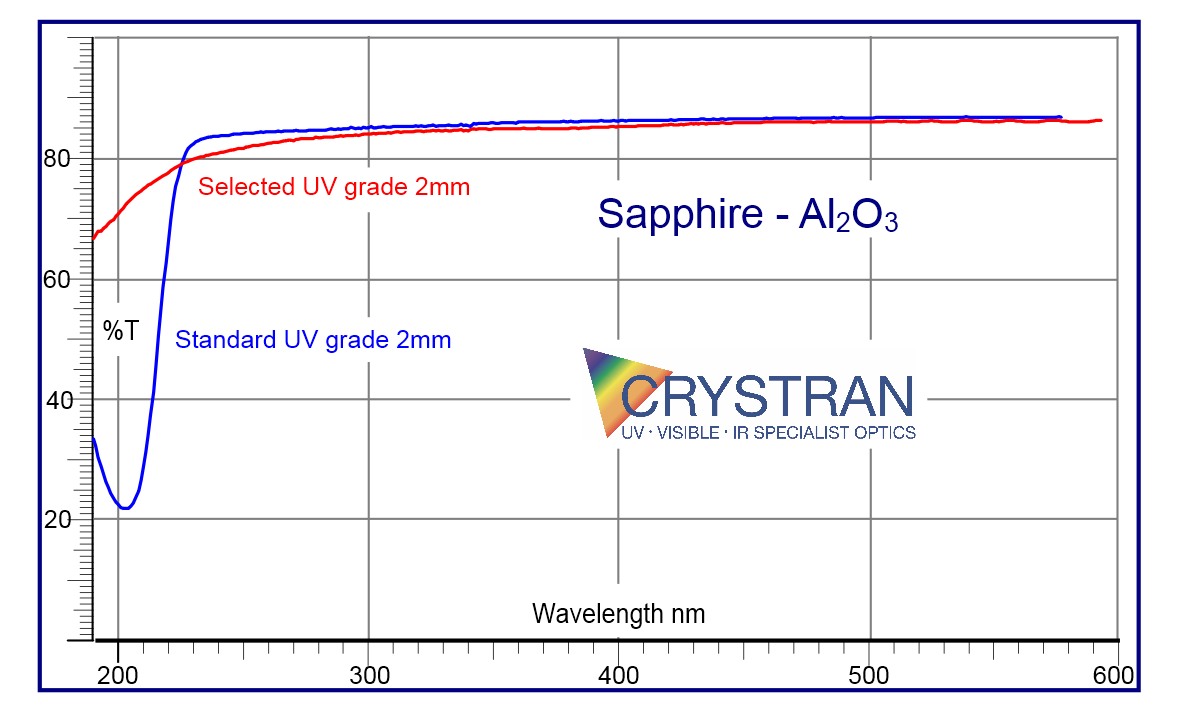

Sapphire Al2O3
Sapphire is used for its extreme toughness and strength. Sapphire is a very useful optical window material for use in the UV, visible, and near infra-red.
♦ Sapphire IR Transmission data table ©2019. Open source for use with acknowledgement.
♦ Sapphire Material. A Quick Guide.




* Note that manufacturers appear to disagree at times on figures for thermal expansion.
| µm | No | Ne |
|---|---|---|
| 0.193 | 1.9288 | 1.9174 |
| 0.213 | 1.8890 | 1.8784 |
| 0.222 | 1.8754 | 1.8650 |
| 0.226 | 1.8702 | 1.8599 |
| 0.244 | 1.8506 | 1.8407 |
| 0.248 | 1.8470 | 1.8372 |
| 0.257 | 1.8393 | 1.8297 |
| 0.266 | 1.8330 | 1.8236 |
| 0.280 | 1.8244 | 1.8151 |
| 0.308 | 1.8110 | 1.8020 |
| 0.325 | 1.8047 | 1.7958 |
| 0.337 | 1.8001 | 1.7921 |
| 0.351 | 1.7969 | 1.7882 |
| 0.355 | 1.7960 | 1.7883 |
| 0.442 | 1.7804 | 1.7721 |
| µm | No | Ne |
|---|---|---|
| 0.458 | 1.7784 | 1.7702 |
| 0.488 | 1.7753 | 1.7671 |
| 0.515 | 1.7730 | 1.7649 |
| 0.532 | 1.7717 | 1.7636 |
| 0.590 | 1.7680 | 1.7600 |
| 0.633 | 1.7659 | 1.7579 |
| 0.670 | 1.7643 | 1.7563 |
| 0.694 | 1.7634 | 1.7554 |
| 0.755 | 1.7614 | 1.7535 |
| 0.780 | 1.7607 | 1.7527 |
| 0.800 | 1.7601 | 1.7522 |
| 0.820 | 1.7596 | 1.7517 |
| 0.980 | 1.7561 | 1.7482 |
| 1.064 | 1.7545 | 1.7466 |
| 1.320 | 1.7501 | 1.7423 |
| µm | No | Ne |
|---|---|---|
| 1.550 | 1.7462 | 1.7384 |
| 2.010 | 1.7375 | 1.7297 |
| 2.249 | 1.7323 | 1.7243 |
| 2.703 | 1.719 | 1.711 |
| 2.941 | 1.712 | 1.704 |
| 3.333 | 1.701 | 1.693 |
| 3.704 | 1.687 | 1.679 |
| 4.000 | 1.674 | 1.666 |
| 4.348 | 1.658 | 1.65 |
| 4.762 | 1.636 | 1.628 |
| 5.000 | 1.623 | 1.615 |
| 5.263 | 1.607 | 1.599 |
Sapphire is grown by a variety of methods. Verneuil and Czochralski methods are usual for standard grade Sapphire material. Higher quality Sapphire, particularly for electronic substrates is manufactured by Kyropulos growth and this can be very pure with excellent UV transmission. Large thin sheets of Sapphire can be made by ribbon growth. Sapphire is slightly birefringent, general purpose IR windows are usually cut in a random way from crystal but for specific applications where the birefringence is an issue, an orientation is selected. Usually this is with the optic axis at 90 degrees to the surface plane and is known as "zero degree" material. Synthetic optical sapphire has no colouration.
* Note that all manufacturers seem to disagree on the actual figures for thermal expansion!
REFERENCES:
(1) Handbook Optical Constants, ed Palik, V3, ISBN 0-12-544423-0
(2) Harrington et al, Appl.Opt. V15, 1953-1959 (1976)
(3) Malitson, J.Opt.Soc.Am., V52, 1377- 1379 (1962)
(4) D. A. Ditmars, et. al., J. Res. Nat. Bur. Stand., 87, (2), 159-163 (1982).
Data provided is extracted from our technical handbook of materials. While every attempt has been made to verify the source of the information, Crystran Ltd accept no responsibility for accuracy of data.